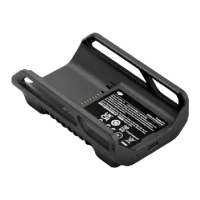DJI Dock 2/Matrice 3D Series Unmanned Aircraft Flight Manual
©
2024 DJI All Rights Reserved.
75
• DO NOT switch from N mode to other modes unless the pilot is suciently familiar
with the aircraft behavior under each ight mode. Make sure to enable Multiple Flight
Modes in DJI Pilot 2 before switching from N mode to other modes.
• The vision system is disabled in S mode, which means the aircraft cannot sense
obstacles on its route automatically. The user must stay alert to the surrounding
environment and control the aircraft to avoid obstacles.
• The maximum speed and braking distance of the aircraft significantly increase in S
mode. A minimum braking distance of 30 m is required in windless conditions while
the aircraft is ying forward, backward, left, or right.
• A minimum braking distance of 10 m is required in windless conditions while the
aircraft is ascending and descending in S mode or N mode.
• The responsiveness of the aircraft signicantly increases in S mode, which means a
small control stick movement on the remote controller translates into the aircraft
moving a large distance. Make sure to maintain adequate maneuvering space when
ying with the remote controller.
• When switching the GNSS to the BeiDou satellite positioning system in DJI Pilot 2,
the aircraft only uses a single positioning system and the satellite search capability
becomes poor. Fly with caution.
RTH
The Return to Home (RTH) function returns the aircraft back to the dock or the alternate
landing site when the GNSS signal is strong. Alternate Landing will be triggered if the dock is not
suitable for landing. In this case, the aircraft will y to and land at the alternate landing site.
Flight tasks will be interrupted and RTH will be triggered if any of these situations occur:
• The aircraft approaches the GEO Zones, or the flight distance approaches the maximum
distance.
• The GNSS signal becomes weak during a ight route task.
• The user actively triggers RTH in DJI FlightHub 2.
• The Intelligent Flight Battery level is too low.
• If the control signal is lost, Signal Lost Action (Return to Home or Continue Task) will be
triggered.
• There is strong wind during a ight route task.
• RTH will be triggered if the motors are overloaded or overheated. Auto landing will be
triggered if there is critical motor overheating warning.
• When performing RTK ight tasks, if the ight distance is too far, RTK positioning accuracy
may decrease. To ensure ight safety, the ight route task will be interrupted and RTH will
be triggered.

